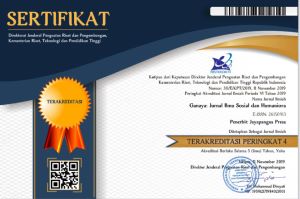Peran Yoga Dalam Meningkatkan Kesehatan Mental, Fisik Dan Kesadaran Spritual Bagi Siswa
DOI:
https://doi.org/10.37329/ganaya.v4i4.3094Keywords:
Health, Students, Yoga ActivitiesAbstract
Health is an optimal physical, mental, and social state, not simply the absence of disease. Implementing wellness involves a healthy lifestyle, health monitoring, good diet, exercise, stress management, and medical care when it is needed. Considering the importance of students' mental and physical health, schools and families can work together to ensure students have optimal health to support students' education. Seeing the rapid progress of technology and the world of education, it cannot be denied that many students are stressed due to cognitive load and so on. The academic environment is a significant source of stress for students which impacts their physical and mental health. This research was prepared using a qualitative approach which displays data processing from observations, interviews, literature, notes or other documents in the form of descriptions using words and accompanied by pictures and not in the form of numbers. yoga practice process at Harapan Nusantara Middle School, Denpasar, guided by a Hindu teacher. Yoha training has a positive impact on individual students' ability to carry out yoga, which will help them to improve mental well-being, help manage stress, increase their concentration in studying and be able to overcome the problem of insomnia faced by today's children. The role of yoga for class VII students at SMP Harapan Nusantara who are aged 12-14 years is very beneficial. By involving students in yoga practices, students here can develop emotionally and physically which is beneficial during the growth period. Currently, without realizing it, all sports activities have a positive correlation with the health of students.References
Cartwright, T., Mason, H., Porter, A., & Pilkington, K. (2020). Yoga practice in the UK: A cross-sectional survey of motivation, health benefits and behaviours. BMJ Open, 10(1), 1-11.
Gadham, J., Sajja, S., & Rooha, V. (2015). Effect of Yoga on obesity, hypertension and lipid profile. International Journal of Research in Medical Sciences, 3(5), 1061.
Grabara, M. (2017). Hatha Yoga as a Form of Physical Activity in the Context of Lifestyle Disease Prevention. Polish Journal of Sport and Tourism, 24(2), 65–71.
Heppner, W. L., & Shirk, S. D. (2018). Mindful moments: A review of brief, low-intensity mindfulness meditation and induced mindful states. Social and Personality Psychology Compass, 12(12).
Khalsa, S. B. S., Hickey-Schultz, L., Cohen, D., Steiner, N., & Cope, S. (2012). Evaluation of the mental health benefits of yoga in a secondary school: A preliminary randomized controlled trial. Journal of Behavioral Health Services and Research, 39(1), 80–90.
Kinasih, A. S. (2010). Pengaruh Latihan Yoga Terhadap Peningkatan Kualitas Hidup. Buletin Psikologi, 18(1), 1–12.
Kiriana, I. N. (2021). Harmonisasi Paksa Siwa Dan Paksa Budha Di Bali (Perspektif Teologi Kontekstual). Jurnal Penelitian Agama Hindu, 5(3), 115-129.
Lundy, A., & Trawick-Smith, J. (2021). Effects of Active Outdoor Play on Preschool Children’s on-Task Classroom Behavior. Early Childhood Education Journal, 49(3), 463–471.
Pascoe, M. C., Thompson, D. R., & Ski, C. F. (2020). Meditation and Endocrine Health and Wellbeing. Trends in Endocrinology and Metabolism, 31(7), 469–477.
Polsgrove, Mj., Eggleston, B., & Lockyer, R. (2016). Impact of 10-weeks of yoga practice on flexibility and balance of college athletes. International Journal of Yoga, 9(1), 27.
Richter, S., Tietjens, M., Ziereis, S., Querfurth, S., & Jansen, P. (2016). Yoga Training in Junior Primary School-Aged Children Has an Impact on Physical Self-Perceptions and Problem-Related Behavior. Frontiers in Psychology, 7.
Shindu, P. (2006). Hidup Sehat dan Seimbang dengan Yoga. Bandung: Qanita.
Sugiarto, R., & Pudja, G. (1982). Swetaswatara Upanisad. Jakarta: Departemen Agama RI.
Sugawara, E., & Nikaido, H. (2014). Properties of AdeABC and AdeIJK efflux systems of Acinetobacter baumannii compared with those of the AcrAB-TolC system of Escherichia coli. Antimicrobial Agents and Chemotherapy, 58(12), 7250–7257.
Tahun, V. N., Orang, P., & Dalam, T. U. A. (2021). Widyalaya : Jurnal Ilmu Pendidikan. 1(3), 328–341.
Wimmer, L., von Stockhausen, L., & Bellingrath, S. (2019). Improving emotion regulation and mood in teacher trainees: Effectiveness of two mindfulness trainings. Brain and Behavior, 9(9).
Yoshihara, K., Hiramoto, T., Oka, T., Kubo, C., & Sudo, N. (2014). Effect of 12 Weeks of Yoga Training on the Somatization, Psychological Symptoms, and Stress-Related Biomarkers of Healthy Women. BioPsychoSocial Medicine, 8(1), 1-9.
Downloads
Published
How to Cite
Issue
Section
License
Copyright (c) 2021 I Gede Purna Wijaya, I Wayan Suwadnyana (Author)

This work is licensed under a Creative Commons Attribution-ShareAlike 4.0 International License.
An author who publishes in the Ganaya : Jurnal Ilmu Sosial dan Humaniora agrees to the following terms:
- Author retains the copyright and grants the journal the right of first publication of the work simultaneously licensed under the Creative Commons Attribution-ShareAlike 4.0 License that allows others to share the work with an acknowledgement of the work's authorship and initial publication in this journal
- Author is able to enter into separate, additional contractual arrangements for the non-exclusive distribution of the journal's published version of the work (e.g., post it to an institutional repository or publish it in a book) with the acknowledgement of its initial publication in this journal.
- Author is permitted and encouraged to post his/her work online (e.g., in institutional repositories or on their website) prior to and during the submission process, as it can lead to productive exchanges, as well as earlier and greater citation of the published work (See The Effect of Open Access).
Read more about the Creative Commons Attribution-ShareAlike 4.0 Licence here: https://creativecommons.org/licenses/by-sa/4.0/.








